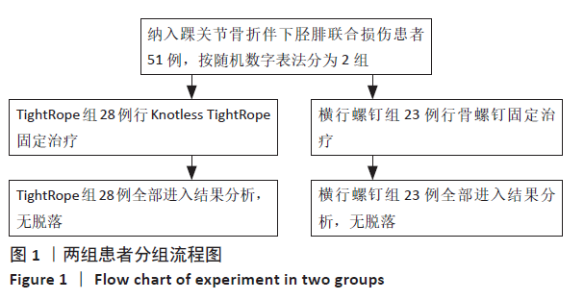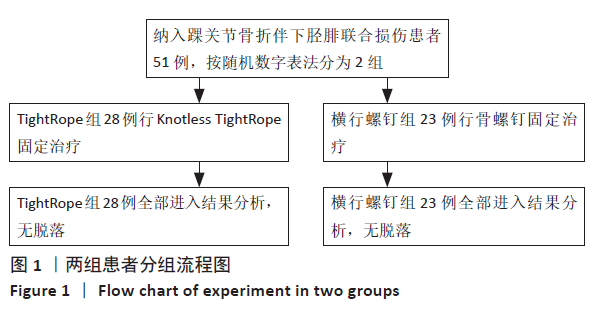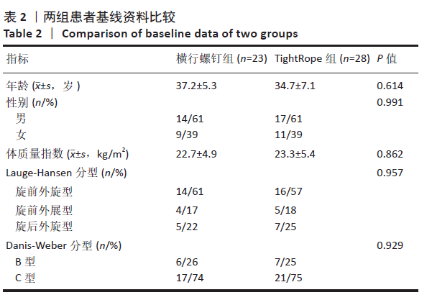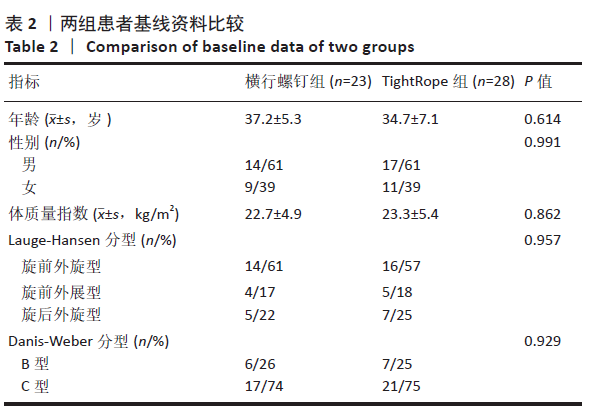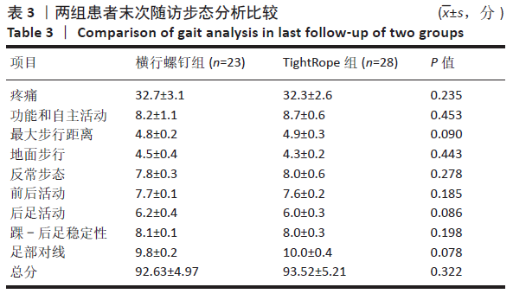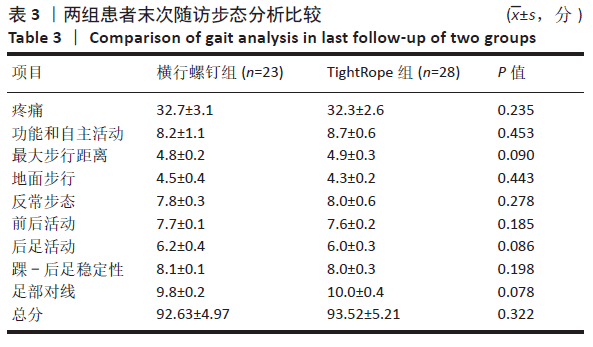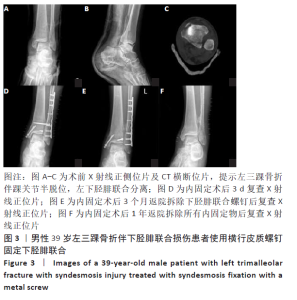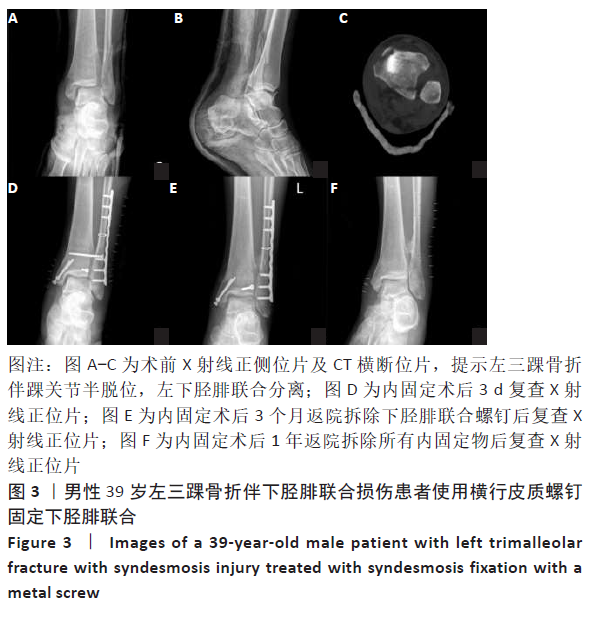Chinese Journal of Tissue Engineering Research ›› 2021, Vol. 25 ›› Issue (30): 4845-4850.doi: 10.12307/2021.272
Previous Articles Next Articles
TightRope versus metallic screw fixation for treatment of tibiofibular syndesmosis injury
Su Boyuan, Yao binfu, Zeng Guanglong, ye Zhongsen, Xie Qingxiang
- Department of Orthopedic Surgery, Dongguan Hospital (Dongguan Hospital of Traditional Chinese Medicine), Guangzhou University of Chinese Medicine, Dongguan 523000, Guangdong Province, China
-
Received:2020-10-20Revised:2020-10-23Accepted:2021-01-07Online:2021-10-28Published:2021-07-29 -
Contact:Su Boyuan, PhD, Associate chief TCM physician, Department of Orthopedic Surgery, Dongguan Hospital (Dongguan Hospital of Traditional Chinese Medicine), Guangzhou University of Chinese Medicine, Dongguan 523000, Guangdong Province, China -
About author:Su Boyuan, PhD, Associate chief TCM physician, Department of Orthopedic Surgery, Dongguan Hospital (Dongguan Hospital of Traditional Chinese Medicine), Guangzhou University of Chinese Medicine, Dongguan 523000, Guangdong Province, China
CLC Number:
Cite this article
Su Boyuan, Yao binfu, Zeng Guanglong, ye Zhongsen, Xie Qingxiang. TightRope versus metallic screw fixation for treatment of tibiofibular syndesmosis injury[J]. Chinese Journal of Tissue Engineering Research, 2021, 25(30): 4845-4850.
share this article
Add to citation manager EndNote|Reference Manager|ProCite|BibTeX|RefWorks
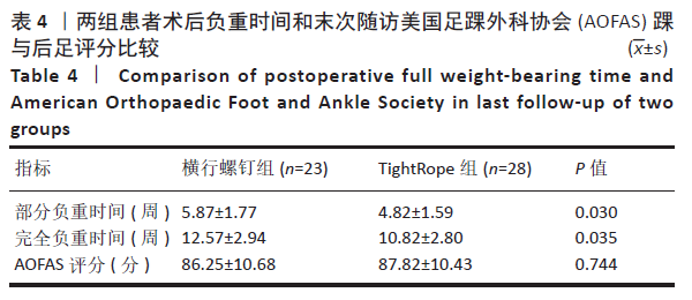
2.5 两组术后负重时间和末次随访AOFAS评分比较 TightRope组术后部分负重时间为(4.82±1.59)周,较横行螺钉组(5.87±1.77)周明显缩短,差异有显著性意义(P < 0.05);TightRope组术后完全负重时间为(10.82±2.80)周,较横行螺钉组(12.57±2.94)周明显缩短,差异有显著性意义(P < 0.05)。 TightRope组末次随访AOFAS评分为(87.82±10.43)分,其中优12例,良16例,优良率为100%(28/28);横行螺钉组末次随访AOFAS评分为(86.25±10.68)分,其中优10例,良13例,优良率为100%(23/23);两组患者AOFAS踝与后足功能评分比较差异无显著性意义(P > 0.05),见表4。"
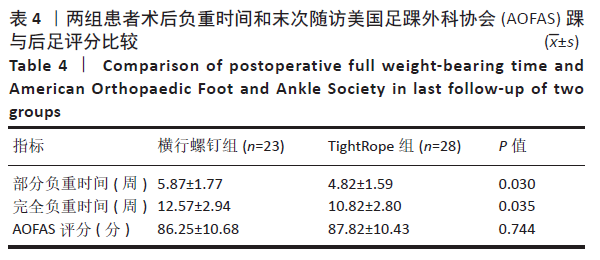
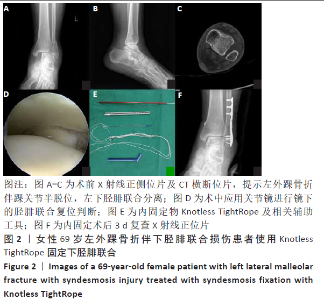
2.6 两组术后并发症比较 两组患者术后即刻完善踝关节正侧位X射线片检查示踝关节各关节面光滑、间隙正常,下胫腓对位满意,未出现螺钉进入关节的情况。其中横行螺钉组1例患者在术后8周完全负重后出现螺钉断裂,手术取出螺钉,X射线片示下胫腓间距、踝关节内侧间隙无明显增宽。所有患者术后切口无感染,切口无软组织激惹,无骨折延迟愈合或不愈合,无患肢深静脉血栓形成及肺部感染等并发症。所有患者约1年后取出所有内固定物,术后复查无关节活动受限,无关节间隙增宽。 2.7 植入物与宿主的生物相容性 两组患者使用的TightRope及横行螺钉生物相容性良好,均未出现植入物周围感染、过敏反应、免疫反应及排斥反应等。 2.8 典型病例 典型病例1:女性患者,69岁,创伤致左踝部肿痛、活动受限1 d,行左外踝骨折切开复位内固定术、经踝关节镜下胫腓韧带修补术,下胫腓联合固定使用Knotless TightRope, 见图2。"
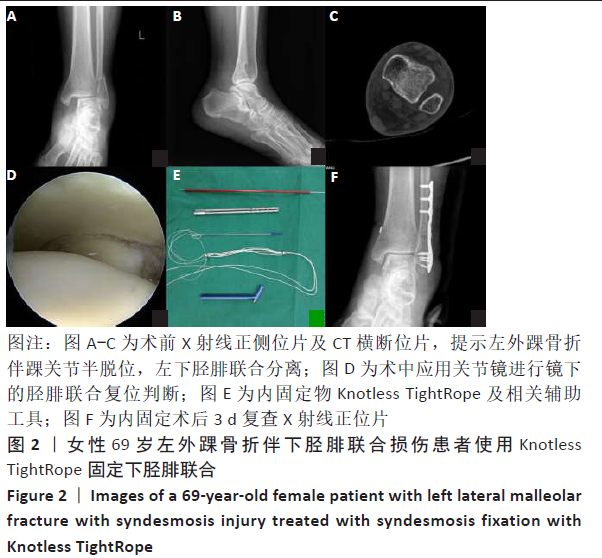
| [1] CHISSELL HR, JONES J. The influence of a diastasis screw on the outcome of Weber type-C ankle fractures. J Bone Joint Surg. 1995; 77(3):435-438. [2] LEEDS HC, EHRLICH MG. Instability of the distal tibiofibular syndesmosis after bimalleolar and trimalleolar ankle fractures. J Bone Joint Surg Am. 1984;66(4):490-503. [3] YAMAGUCHI K, MARTIN CH, BODEN SD, et al. Operative treatment of syndesmotic disruptions without use of a syndesmotic screw: a prospective clinical study. Foot Ankle Int. 1994;15(8):407. [4] MORRIS JR, LEE J, THORDARSON D, et al. Magnetic resonance imaging of acute Maisonneuve fractures. Foot Ankle Int. 1996;17(5):259-263. [5] PANKOVICH AM. Maisonneuve fracture of the fibula. J Bone Joint Surg Am.1976;58(3):337-442. [6] BEUMER A, CAMPO MM, NIESING R, et al. Screw fixation of the syndesmosis: a cadaver model comparing stainless steel and titanium screws and three and four cortical fixation. Injury. 2005;36(1):60-64. [7] BODEN SD, LABROPOULOS PA, MCCOWIN P, et al. Mechanical considerations for the syndesmosis screw. A cadaver study. J Bone Joint Surg Am. 1989;71(10):1548-1555. [8] COTTOM JM, HYER CF, PHILBIN TM, et al. Treatment of syndesmotic disruptions with the Arthrex Tightrope: a report of 25 cases. Foot Ankle Int. 2008;29(8):773-780. [9] THORNES B, SHANNON F, GUINEY AM, et al. Suture-button syndesmosis fixation: accelerated rehabilitation and improved outcomes. Clin Orthop Relat Res. 2005;431(431):207-212. [10] MCMURRAY D, HORNUNG B, VENKATESWARAN B, et al. Walking on a tightrope: Our experience in the treatment of traumatic ankle syndesmosis rupture. Injury Extra. 2008;39(5):182-182. [11] WILLMOTT HJ, SINGH B, DAVID LA. Outcome and complications of treatment of ankle diastasis with tightrope fixation. Injury. 2010; 41(10):1096. [12] SEITZ WH, BACHNER EJ, ABRAM LJ, et al. Repair of the tibiofibular syndesmosis with a flexible implant. Orthop Trauma. 1991;5(1):78-82. [13] DEGROOT H, AL-OMARI AA, EL GHAZALY SA. Outcomes of suture button repair of the distal tibiofibular syndesmosis. Foot Ankle Int. 2011;32(3): 250-256. [14] HARPER MC, KELLER TS. A Radiographic Evaluation of the Tibiofibular Syndesmosis. Foot Ankle Int. 1989;10(3):156-160. [15] EBRAHEIM NA, LU J, YANG H, et al. Radiographic and CT evaluation of tibiofibular syndesmotic diastasis: a cadaver study. Foot Ankle Int. 1997;18(11):693. [16] MASSIMILIANO C, GIOVANNI V, VITO P, et al. Beyond the pillars of the ankle: a prospective randomized CT analysis of syndesmosis’ injuries in Weber B and C type fractures. Injury. 2018;49(3):S54-S60. [17] HARPER MC. Delayed reduction and stabilization of the tibiofibular syndesmosis. Foot Ankle Int. 2001;22(1):15-18. [18] PAKARINEN H, FLINKKILÄ T, OHTONEN P, et al. Intraoperative assessment of the stability of the distal tibiofibular joint in supination-external rotation injuries of the ankle: sensitivity, specificity, and reliability of two clinical tests. J Bone Joint Surg Am. 2011;93(22):2057-2061. [19] TAKAO M, OCHI M, NAITO K, et al. Arthroscopic diagnosis of tibiofibular syndesmosis disruption. Arthrosc J Arthrosc Relat Surg. 2001;17(8):836-843. [20] TAKAO M, OCHI M, OAE K, et al. Diagnosis of a tear of the tibiofibular syndesmosis. The role of arthroscopy of the ankle. J Bone Joint Surg. 2003;85(3):324-329. [21] HOINESS P, STROMSOE K. Tricortical versus quadricortical syndesmosis fixation in ankle fractures: a prospective, randomized study comparing two methods of syndesmosis fixation. J Orthop Trauma. 2004;18(6): 331-337. [22] FRITSCHY D. An unusual ankle injury in top skiers. Am J Sports Med. 1989;17(2):282-286. [23] MCBRYDE A, CHIASSON B, WILHELM A, et al. Syndesmotic screw placement: a biomechanical analysis. Foot Ankle Int. 1997;18(5):262-266. [24] COETZEE JC, EBELING P. Treatment of syndesmoses disruptions: a prospective, randomized study comparing conventional screw fixation vs Tightrope1 fiber wire fixation-medium term results. South African Orthopaedic J. 2009;8(1):32-37. [25] MANJOO A, SANDERS DW, TIESZER C, et al. Functional and radiographic results of patients with syndesmotic screw fixation: implications for screw removal. J Orthop Trauma. 2010;24(1):2-6. [26] XIE L, XIE H, WANG J, et al. Comparison of suture button fixation and syndesmotic screw fixation in the treatment of distal tibiofibular syndesmosis injury: a systematic review and meta-analysis. Int J Surg. 2018;60:120-131. [27] TERAMOTO A, SHOJI H, SAKAKIBARA Y, et al. Suturebutton fixation and mini-open anterior inferior tibiofibular ligament augmentation using suture tape for tibiofibular syndesmosis injuries. J Foot Ankle Surg. 2018;57:159-161. [28] ONGGO JR, NAMBIAR M, PHAN K, et al. Suture button versus syndesmosis screw constructs for acute ankle diastasis injuries: a meta-analysis and systematic review of randomised controlled trials. Foot Ankle Surg. 2018;11(18):30364-30363. [29] COLCUC C, BLANK M, STEIN T, et al. Lower complication rate and faster return to sports in patients with acute syndesmotic rupture treated with a new knotless suture button device. Knee Surg Sports Traumatol Arthrosc. 2018;26:3156-3164. [30] SCHEPERS T. Acute distal tibiofibular syndesmosis injury: a systematic review of suture-button versus syndesmotic screw repair. Int Orthop. 2012;36(6):1199-1206. [31] CHERNEY SM, COSGROVE CT, SPRAGGS-HUGHES AG, et al. Functional outcomes of syndesmotic injuries based on objective reduction accuracy at a minimum 1-year follow-up. J Orthop Trauma. 2018;32(1): 43-51. [32] ROBBIE R, NINA K, CLEMENT NICK D, et al. Ankle fractures with syndesmotic stabilisation are associated with a high rate of secondary osteoarthritis. Foot Ankle Surg. 2019;25(2):180-185. [33] DEBERARDINO TM, SMITH PA, COOK JL. Femoral Suspension Devices for Anterior Cruciate Ligament Reconstruction: Letter to the Editor. Am J Sports Med. 2014;42(2):NP15-16. [34] PETRE BM , SMITH SD, JANSSON KS, et al. Femoral Cortical Suspension Devices for Soft Tissue Anterior Cruciate Ligament Reconstruction A Comparative Biomechanical Study. Am J Sports Med. 2013;41(2):416-422. [35] STRUHL S. Double Endobutton Technique for Repair of Complete Acromioclavicular Joint Dislocations. Tech Shoulder Elbow Surg. 2007; 8(4):175-179. [36] COTTOM JM, HYER CF, PHILBIN TM, et al. Transosseous fixation of the distal tibiofibular syndesmosis: comparison of an interosseous suture and endobutton to traditional screw fixation in 50 cases. J Foot Ankle Surg. 2009;48(6):620-630. [37] NAQVI GA, SHAFQAT A, AWAN N. Tightrope fixation of ankle syndesmosis injuries: clinical outcome, complications and technique modification. Injury. 2012;43(6):838-842. [38] THORNES B, WALSH A, HISLOP M, et al. Suture-Endobutton fixation of ankle tibio-fibular diastasis: A cadaver study. Foot Ankle Int. 2003; 24(2):142-146. [39] FORSYTHE K, FREEDMAN KB, STOVER MD, et al. Comparison of a novel FiberWire-button construct versus metallic screw fixation in a syndesmotic injury model. Foot Ankle Int. 2008;29(1):49-54. [40] SHOJI H, TERAMOTO A, SUZUKI D, et al. Suture-button fixation and anterior inferior tibiofibular ligament augmentation with suture-tape for syndesmosis injury: A biomechanical cadaveric study. Clin Biomech. 2018;60:121-126. [41] BARROW AE, PILIA M, GUDA T, et al. Femoral suspension devices for anterior cruciate ligament reconstruction: do adjustable loops lengthen. Am J Sports Med. 2014;42(2):15-16. [42] LEHTONEN EJ, PINTO MC, PATEL HA, et al. Syndesmotic fixation with suture button: Neurovascular structures at risk: A cadaver study. Foot Ankle Spec. 2020;13:12-17. |
| [1] | Ouyang Beiping, Ma Xiangyang, Luo Chunshan, Zou Xiaobao, Lu Tingsheng, Chen Qiling. Three-dimensional finite element analysis of a new horizontal screw-screw crosslink in posterior atlantoaxial internal fixation [J]. Chinese Journal of Tissue Engineering Research, 2024, 28(9): 1320-1324. |
| [2] | Niu Hegang, Yang Kun, Zhang Jingjing, Yan Yizhu, Zhang Yinshun. Design of a new posterior atlas fracture reduction and internal fixation system [J]. Chinese Journal of Tissue Engineering Research, 2024, 28(9): 1399-1402. |
| [3] | Wang Menghan, Qi Han, Zhang Yuan, Chen Yanzhi. Three kinds of 3D printed models assisted in treatment of Robinson type II B2 clavicle fracture [J]. Chinese Journal of Tissue Engineering Research, 2024, 28(9): 1403-1408. |
| [4] | Xue Xiaofeng, Wei Yongkang, Qiao Xiaohong, Du Yuyong, Niu Jianjun, Ren Lixin, Yang Huifeng, Zhang Zhimin, Guo Yuan, Chen Weiyi. Finite element analysis of osteoporosis in proximal femur after cannulated screw fixation for femoral neck fracture [J]. Chinese Journal of Tissue Engineering Research, 2024, 28(6): 862-867. |
| [5] | Zheng Jiafa, Song Xiufeng, Li Hongzhi, Zhou Jinming, Guan Shengyi, Yu He. Open reduction and internal fixation via the para-Achilles tendon approach for the treatment of posterior malleolus sandwich fractures [J]. Chinese Journal of Tissue Engineering Research, 2024, 28(6): 934-938. |
| [6] | Wang Qiang, Li Shiyun, Xiong Ying, Li Tiantian. Biomechanical changes of the cervical spine in internal fixation with different anterior cervical interbody fusion systems [J]. Chinese Journal of Tissue Engineering Research, 2024, 28(6): 821-826. |
| [7] | Wei Yuanbiao, Lin Zhan, Chen Yanmei, Yang Tenghui, Zhao Xiao, Chen Yangsheng, Zhou Yanhui, Yang Minchao, Huang Feiqi. Finite element analysis of effects of sagittal cervical manipulation on intervertebral disc and facet joints [J]. Chinese Journal of Tissue Engineering Research, 2024, 28(6): 827-832. |
| [8] | Yu Zhaoyu, Tan Lixin, Sun Kai, Lu Yao, Li Yong. Meta-analysis of cement-augmented pedicle screw for thoracolumbar degenerative diseases with osteoporosis [J]. Chinese Journal of Tissue Engineering Research, 2024, 28(5): 813-820. |
| [9] | Huang Jiacheng, Shao Xinxin, Li Haomiao, Du Shaohua, Dai Shuangwu. Construction of an animal model for treating early postoperative infected bacterial biofilms by irrigating after internal fixation [J]. Chinese Journal of Tissue Engineering Research, 2024, 28(23): 3704-3708. |
| [10] | Ye Xiaolong, Ma Yuan. Visualization analysis of magnetically controlled growing rod in treatment of spinal deformities [J]. Chinese Journal of Tissue Engineering Research, 2024, 28(15): 2323-2329. |
| [11] | Xiong Bohan, Lu Xiaojun, Xue Wenqiang, Liu Jinrui, Gao Xianling, Yu Hong, Li Yajuan, Liu Haolong, Li Yanlin. Protective effect of anterior cruciate ligament reconstruction assisted by internal tension-reduction technique on the articular cartilage of southern Yunnan small-ear pigs [J]. Chinese Journal of Tissue Engineering Research, 2024, 28(14): 2221-2226. |
| [12] | Zhu Ruizhi, Qu Qiang, Cui Pengfei, Liu Dong, Zhang Yongtao, Wang Changyao. Efficacy of joint replacement versus closed reduction and internal fixation in treatment of unstable intertrochanteric fractures combined with osteoporosis [J]. Chinese Journal of Tissue Engineering Research, 2024, 28(12): 1869-1874. |
| [13] | Wang Anquan, Chen Hao, Hua Xingyi, Lu Xiaolin, Zhou Jian, Cui Yiliang, Li Guangyu, Yin Zongsheng. Proximal femoral nail antirotation Asian version for treating femoral intertrochanteric fractures: comparison of the protruding degree of intramedullary nails in Asian population [J]. Chinese Journal of Tissue Engineering Research, 2024, 28(12): 1901-1906. |
| [14] | Shi Haoran, Guan Haishan, Wang Yueyong, Liu Tao. Decompression and fusion for degenerative lumbar spondylolisthesis affect sagittal disequilibrium of the spine [J]. Chinese Journal of Tissue Engineering Research, 2024, 28(12): 1956-1961. |
| [15] | Han Biao, Li Ji, Li Bin, Sun Bo, Zong Shuangle, Wang Hongrun, Li Dongmei, Li Ligeng, Wang Bin. Finite element analysis of optimal fixation method for femoral neck fracture with different reduction conditions [J]. Chinese Journal of Tissue Engineering Research, 2024, 28(12): 1810-1814. |
| Viewed | ||||||
|
Full text |
|
|||||
|
Abstract |
|
|||||
